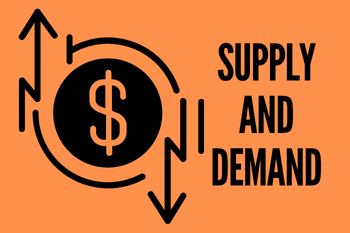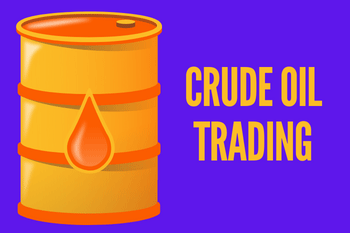We all know crude oil is a significant source of energy and is used to produce gasoline and plastics. Therefore the price of crude oil is determined by supply and demand. When the demand for gas goes up, so does the price of crude oil. The supply of crude oil is also important. The Organization of the Petroleum Exporting Countries (OPEC) controls a large portion of the world’s crude oil supply. OPEC can influence the price of crude oil by changing its production levels. Non-OPEC countries also produce crude oil. These countries include the United States, Canada, and Mexico.

What is Crude Oil Trading?
Crude oil trading is the buying and selling of crude oil contracts on a commodities exchange. Crude oil is a naturally occurring fossil fuel, consisting of hydrocarbons that can be refined to produce gasoline, diesel, and other petroleum products.
Commodity exchanges where crude oil is traded include the New York Mercantile Exchange (NYMEX), the International Petroleum Exchange (IPE), and the Tokyo Commodity Exchange (TOCOM). Trading in crude oil futures began in 1882 on the NYMEX, with the introduction of West Texas Intermediate crude oil futures.
Today, NYMEX WTI crude oil futures are the most actively traded contract on any U.S. exchange. Each NYMEX WTI crude oil futures contract represents 1,000 barrels of crude oil and is priced in U.S. dollars per barrel. The minimum tick size for NYMEX WTI crude oil futures is $0.01 per barrel ($10 per contract) and they are listed for trading from January through December of each year.
The IPE Brent Crude Oil Futures contract represents 1,000 barrels of Brent crude oil and is priced in U.S. dollars and cents per barrel. The minimum tick size for IPE Brent Crude Oil Futures is $0.01 per barrel ($10 per contract). IPE Brent Crude Oil Futures are listed for trading from January through December of each year on the IPE floor and electronically on CME Globex.
TOCOM Crude Oil Futures are traded in Japanese yen per kiloliter and each contract represents 500 barrels of crude oil. The minimum price fluctuation is ¥1 per kiloliter ($10 per contract) and TOCOM Crude Oil Futures are listed for trading from January through December of each year.
The History of Crude Oil Trading
The history of crude oil trading is a long and complicated one, with different countries vying for control of the world's most important commodity. The first recorded crude oil transaction took place in Scotland in 1851, when oil was discovered in the North Sea.
Since then, the global trade in crude oil has grown exponentially, with countries all over the world now taking part. The United States is currently the largest producer of crude oil, followed by Saudi Arabia and Russia. These three countries account for almost 60% of the world's total production.
How The Crude Oil Prices Are Determined
The price of crude oil is determined by a number of factors, including global demand, supply levels, geopolitical tensions and weather conditions.
Supply and Demand

Supply levels affect how much oil is available on the market, and global demand dictates how much oil needs to be produced. If there is more demand than there is supply, then prices will increase as buyers compete for limited resources. On the other hand, if there is more supply than demand, then prices will fall as sellers look to offload excess inventory.
Geopolitical Tensions
Geopolitical tensions can also have a big impact on prices, as they can cause disruptions to supplies or lead to increases in demand. For example, tensions between Saudi Arabia and Iran could lead to disruptions in shipments from the Middle East, while an escalation in fighting in Syria could lead to increased demand from European countries as they look to secure supplies.
Weather Conditions
Extreme weather can disrupt the production or transportation of crude oil, therefore have an impact on prices. For example, a hurricane in the Gulf of Mexico could lead to production being shut down for several weeks, while a cold snap in Europe could lead to increased demand for heating oil.
How to Trade Crude Oil
Crude oil is one of the most popular commodities traded on the market today. Here are some tips on how to trade crude oil:
1. Know the different types of crude oil.
There are two main types of crude oil - light and heavy. Each type has different characteristics and therefore trades differently on the market.
2. Understand how supply and demand affect crude oil prices.
Crude oil prices are largely determined by supply and demand fundamentals. Keep an eye on key factors such as production levels, geopolitical events, and inventory levels to get a sense of where prices might go in the future.
3. Use technical analysis when trading crude oil.
Just like with any other commodity or financial instrument, technical analysis can be a helpful tool when trading crude oil. Look for chart patterns or indicators that could give you clues about future price movements.
4. Have a plan before you trade.
Before entering any trade, it’s important to have a clear plan in place. Know your entry and exit points, as well as your risk management strategy. This will help you stay disciplined and avoid making impulsive decisions while trading.
5 Start small when you’re first starting out.
It’s always best to start small when venturing into new territory like commodity trading. By doing so, you can minimize your risk and get a feel for how the market works before putting more capital at stake.
How Crude Oil Trading Works

Now you understand the basics of the commodity market and how oil prices are determined. If you're looking to get involved in crude oil trading, there are a few things you need to know in order to make a profit.
Firstly, find a reputable broker that can provide you with the resources and tools you need to trade.
A common strategy used by many traders is simply buying oil when prices are low and selling when they rise. However, there are many other strategies that can be used, and it's important that you find one that fits your own trading style.
It's also important to remember that crude oil trading is a risky business, so you should never invest more money than you can afford to lose. always use stop-loss orders to protect your capital, and don't hesitate to take profits when they're available. By following these tips, you can give yourself a better chance of success in the world of crude oil trading.
What are the Risks of Crude Oil Trading?
There are a number of risks associated with trading crude oil. These include:
- The price of crude oil is highly volatile, meaning that it can move up or down sharply in a short space of time. Due to this, it is a risky investment, because a decline in price could result in a loss of capital.
- There is also the political risk to consider. Crude oil is produced in some politically unstable countries, which means that supply could be disrupted if there are tensions in the region. This would lead to a rise in prices, which would hit your profits.
How to Choose the Right Crude Oil Trading Platform
If you're looking to trade crude oil, there are a few things you should consider before choosing a trading platform.
- If you're a day trader, you'll want a platform with low commissions and fast order execution. If you're a position trader, you'll want a platform with advanced charting and analysis tools.
- Crude oil is just one commodity, and there are many different platforms that offer different assets. Make sure the platform you choose offers the assets you're interested in trading.
- Some platforms offer mobile trading apps, while others have more complex options trading capabilities. Consider what features are most important to you before making your final decision.
Crude Oil Trading Strategies
When it comes to trading crude oil, there are a few different strategies that you can employ in order to try and make a profit.
High/Low
The first is to simply buy low and sell high – in other words, to buy when the price of oil is low and to sell when the price is high. This strategy is relatively simple, but it can be difficult to time the market correctly in order to make a profit.
Scalping
Scalping involves taking small profits on a regular basis, rather than waiting for a big price movement in one direction or the other. Scalpers will often buy and sell multiple times throughout the day, looking to take advantage of small price fluctuations. This can be a very profitable strategy if done correctly, but it does require a lot of time and effort in order to be successful.
Contrarian Investing
Contrarian investing involves taking positions that are contrary to the current trend in the market. For example, if everyone else is selling because they think the price of oil is going to drop, a contrarian trader might instead buy because they believe that the price will rebound soon. Contrarian investing can be risky, but it can also lead to large profits if timed correctly.
Conclusion
This article has provided an overview of commodity crude oil trading. We have looked at what crude oil is, how it is traded, and the benefits and risks associated with trading this commodity. Commodity trading can be a great way to make money, but it is important to do your research and understand the risks involved before entering into any trades.
